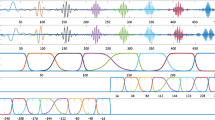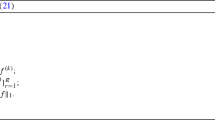Abstract
In this paper, an algorithm for image reconstruction from gradient data based on the Haar wavelet decomposition is proposed. The proposed algorithm has two main stages. First, the Haar decomposition of the image to be reconstructed is obtained from the given gradient data set. Then, the Haar wavelet synthesis is employed to produce the image. The proposed algorithm is based on the relationship between the Haar analysis and synthesis filters and the model for the discretized gradient. The approach presented here is based on the one by Hampton et al. (IEEE J Sel Top Signal Process 2(5):781–792, 2008) for wavefront reconstruction in adaptive optics. The main strength of the proposed algorithm lies in its multiresolution nature, which allows efficient processing in the wavelet domain with complexity \({\fancyscript{O}}(N)\). In addition, obtaining the wavelet decomposition of the image to be reconstructed provides the possibility for further enhancements of the image, such as denoising or smoothing via iterative Poisson solvers at each resolution during Haar synthesis. To evaluate the performance of the proposed algorithm, it is applied to reconstruct ten standard test images. Experiments demonstrate that the algorithm yields results comparable in terms of solution accuracy to those produced by well-known benchmark algorithms. Further, experiments show that the proposed algorithm is suitable to be employed as a final step to reconstruct an image from a gradient data set, in applications such as image stitching or image morphing.










Similar content being viewed by others
Notes
Source of MATLAB code: http://www.umiacs.umd.edu/~aagrawal/software.html; shapelets: http://www.csse.uwa.edu.au/~pk/research/matlabfns/.
Source of MATLAB code: http://www.mathworks.com/matlabcentral/fileexchange/authors/321598.
The test images used in this example were downloaded from http://www.pbase.com/ckuhn55/wyoming/.
The images are part of the Yale Face Database.
References
Agrawal, A., & Raskar, R. (2006). What is the range of surface reconstructions from a gradient field. In Proceedings of the European conference on computer vision (pp. 578–591).
Agrawal, A., Raskar, R., Nayar, S. K., & Li, Y. (2005). Removing photography artifacts using gradient projection and flash-exposure sampling. ACM Transactions on Graphics, 24(3), 828–835.
Boutellier, J., Silvén, O., Tico, M., Korhonen, L., et al. (2008). Objective evaluation of image mosaics. In J. Braz (Ed.), Computer vision and computer graphics. Theory and applications (pp. 107–117). Berlin, Heidelberg: Springer.
Burt, P., & Adelson, E. (1983). A multiresolution spline with application to image mosaics. ACM Transactions on Graphics, 2, 217–236.
Craine, B., Craine, E., O’Toole, C., & Ji, Q. (1998). Digital imaging colposcopy: Corrected area measurements using shape-from-shading. IEEE Transactions on Medical Imaging, 17(6), 1003–1010.
Fattal, R., Lischinski, D., & Werman, M. (2002). Gradient domain high dynamic range compression. ACM Transactions on Graphics, 21(3), 249–256.
Finlayson, G., Hordley, S., & Drew, M. (2002). Removing shadows from images. In Proceedings of the European conference on computer vision (pp. 823–836).
Frankot, R., & Chellappa, R. (1988). A method for enforcing integrability in shape from shading algorithms. IEEE Transactions on Pattern Analysis and Machine Intelligence, 10, 439–451.
Fried, D. (1977). Least square fitting a wavefront distortion estimate to an array of phase difference measurements. Journal of the Optical Society of America, 67, 370–374.
Gillan, S., Agathoklis, P., & Yasein, M. (2009). A feature based technique for face recognition using Mexican hat wavelets. In IEEE Pacific rim conference on communications, computers and signal processing (pp. 792–797)
Gilles, L., Vogel, C., & Ellerbroek, B. L. (2002). Multigrid preconditioned conjugate-gradient method for large-scale wave-front reconstruction. Journal of the Optical Society of America, 19(9), 1817–1822.
Hampton, P., & Agathoklis, P. (2010). Comparison of Haar wavelet-based and Poisson-based numerical integration techniques. In Proceedings of IEEE international symposium on circuits and systems (pp. 1623–1626).
Hampton, P., Agathoklis, P., & Bradley, C. (2008). A new wave-front reconstruction method for adaptive optics system using wavelets. IEEE Journal of Selected Topics in Signal Processing, 2(5), 781–792.
Hampton, P., Agathoklis, P., & Bradley, C. (2009). Wavefront reconstruction over a circular aperture using gradient data extrapolated via the mirror equations. Applied Optics, 48(20), 4018–4030.
Harker, M., & O’Leary, P. (2008). Least squares surface reconstruction from measured gradient fields. In IEEE conference on computer vision and pattern recognition. CVPR (pp. 1–7).
Harker, M. & O’Leary, P. (2013a). Direct regularized surface reconstruction from gradients for industrial photometric stereo. Computers in Industry doi:10.1016/j.compind.2013.03.013.
Harker, M. & O’Leary, P., (2013b). Regularized reconstruction of a surface from its measured gradient field. http://arxiv.org/pdf/1308.4292.pdf.
Hertzmann, A., & Seitz, S. (2005). Example-based photometric stereo: shape reconstruction with general, varying BRDFs. IEEE Transactions on Pattern Analysis and Machine Intelligence, 27(8), 1254–1264.
Hsu, C.-T., & Wu, J.-L. (1996). Multiresolution mosaic. IEEE Transactions on Consumer Electronics, 42(4), 981–990.
Hudgin, R. (1977). Wave-front reconstruction for compensated imaging. Journal of the Optical Society of America, 67, 375–378.
Kovesi, P. (2005). Shapelets correlated with surface normals produce surfaces. In ICCV05 (pp. 994–1001).
Lalonde, J.-F., Hoiem, D., Efros, A. A., Rother, C., Winn, J., & Criminisi, A. (2007). Photo clip art. ACM Transactions on Graphics, 26. http://dl.acm.org/citation.cfm?id=1275808.1276381&coll=DL&dl=ACM&CFID=257078954&CFTOKEN=11593042.
Levin, A., Zomet, A., Peleg, S., & Weiss, Y. (2004). Seamless image stitching in the gradient domain. In Proceedings of the European conference on computer vision, (Vol. 4, pp. 377–389).
Perez, P., Gangnet, M. & Blake, A. (2003). Poisson image editing. In Proceedings of SIGGRAPH’03, (pp. 313–318).
Poyneer, L. A., & Véran, J.-P. (2005). Optimal modal Fourier-transform wavefront control. Journal of the Optical Society of America, 22(8), 1515–1526.
Rash, C. E., Russo, M. B., Letowski, T. R. & Schmeisser, E. T. (eds.) (2009). Helmet-Mounted displays: sensation, perception and cognition issues, U.S. Army Aeromedical Research Laboratory, Fort Rucker, Alabama, USA, Chap. 10.
Reddy, D., Agrawal, A., & Chellappa, R. (2009). Enforcing integrability by error correction using \(\ell _1\)-minimization (pp. 2350–2357). In IEEE Conference on computer vision and pattern recognition.
Seitz, S. M., & Dyer, C. R. (1996). View morphing. In Proceedings of SIGGRAPH’96, (pp. 21–30).
Sevcenco, I. S., Hampton, P. J., & Agathoklis, P. (2011). Seamless stitching of images based on a Haar wavelet 2D integration method. In 17th International conference on digital signal processing (DSP) (pp. 1–6).
Simchony, T., Chellappa, R., & Shao, M. (1990). Direct analytical methods for solving Poisson equations in computer vision problems. IEEE Transactions on Pattern Analysis and Machine Intelligence, 12, 435–446.
Smith, W. A. P., & Hancock, E. (2006). Face recognition using 2.5D shape information. In Proceedings of IEEE computer society conference on computer vision and pattern recognition, (Vol. 2, pp. 1407–1414).
Tumblin, J., Agarwal, A., & Raskar, A. (2005). Why I want a gradient camera. In Proceedings of IEEE computer society conference on computer vision and pattern recognition (Vol. 1, pp. 103–110).
Vetterli, M., & Kovačević, J. (1995). Wavelets and subband coding. Englewood Cliffs, NJ: Prentice-Hall.
Vogel, C. R., & Yang, Q. (2006). Multigrid algorithm for least-squares wavefront reconstruction. Applied Optics, 45(4), 705–715.
Watkins, D. S. (2002). Fundamentals of matrix computations. New York, USA: Wiley.
Wolberg, G. (1996). Recent advances in image morphing. In Proceedings of the 1996 conference on computer graphics, international (pp. 64–71).
Yasein, M., & Agathoklis, P. (2007). A robust, feature-based algorithm for aerial image registration. In IEEE international symposium on industrial electronics (pp. 1731–1736).
Author information
Authors and Affiliations
Corresponding author
Appendices
Appendix 1: Algorithm proof
Given the Hudgin derivatives components \(\Phi ^H_x\) and \(\Phi ^H_y\), the wavelet decomposition of \(\Phi \) can be obtained using Eq. (19)–(26).
Proof
From wavelet theory, it is known that the HH subband of the Haar wavelet decomposition of a 2D surface is given by:
where \(H_H\left( z\right) \) is the highpass analysis Haar wavelet filter described by (2) and the variables \(z_h\) and \(z_v\) indicate the horizontal and vertical direction of filtering, respectively.
With the connection between the Haar wavelet filters and discretization model in mind, we can write Eq. (33) as follows:
Next, according to the observation made in Sect. 2.2, we can replace \(\sqrt{2} \cdot \Phi H_H \left( z_h\right) \) with the given \(\Phi _x^H\). Doing so yields:
Further, we note that:
This observation allows us to replace \(2\Phi _x^H H_H \left( z_v\right) \) with \(\Phi _x^HH_H\left( z_v\right) + \Phi _y^HH_H\left( z_h\right) \), and so Eq. (34) becomes:
This concludes the proof of Eq. (21). Please note that the downsampler in front of the square brackets of the right hand-side term is two directional (i.e., the downsampling is done horizontally and vertically). The proof of Eq. (19)–(20), and (22)–(22) can be found in Hampton et al. (2008).
Appendix 2: Performance comparison
Rights and permissions
About this article
Cite this article
Sevcenco, I.S., Hampton, P.J. & Agathoklis, P. A wavelet based method for image reconstruction from gradient data with applications. Multidim Syst Sign Process 26, 717–737 (2015). https://doi.org/10.1007/s11045-013-0262-3
Received:
Revised:
Accepted:
Published:
Issue Date:
DOI: https://doi.org/10.1007/s11045-013-0262-3




